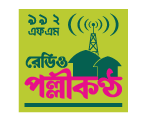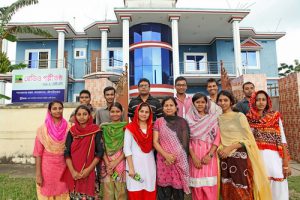The advent of community radio has recently emerged as an important tool for empowering marginalised sections of society across the world, transforming lives through giving them access to relevant, up-to-date information. BRAC Community Empowerment Programme’s recent initiative, Radio Pollikontho-99.2FM, a community radio project based in Chadnighat union, Moulvibazar is an example of this.
The station broadcasts information within a 17km radius, reaching roughly 400,000 people with programmes tailored toward building awareness on a variety of issues such as education, agriculture, healthcare, women’s empowerment, alongside other bits of information specific to the community, such as dates for vaccination programmes. Currently on air for four hours daily, the programmes are scheduled according to the listening habits of different groups such as children, youth, women and mixed adults. Listeners’ clubs have been formed in order to assess the effectiveness of the programmes. So far 769 listeners clubs have been formed.
The station manager leads the team, shouldering the responsibility of monitoring and co-ordinating his team members. Apart from supervising the team, he also communicates with local influentials, gathers ideas, etc. ‘A radio station is a platform where accurate and productive information is disseminated,’ he says.
The program producer maps out different programmes based on the community’s needs. He delegates the key player (presenters) to carry out the need analysis, and assists in scriptwriting. He believes that ‘the bottom line of poverty’ is a lack of productive information, and that a radio station can ‘facilitate the distribution of dynamic information’.
The Technical Producer blends the whole programme, which is called ‘MIXDOWN’. He crafts the script with background music before the programme is broadcast..
The Presenters
Each of the 10 presenters proactively play the role of reporting from the field as well as presenting in the studio. As you can imagine, their role entails a number of responsibilities
Typically, presenters carry out a need analysis through an interview that forms part of their work in the field. They identify farmers, teachers,
| On Air date | 25 October 2011 |
| Broadcasting hour and time | Hour: 12 Time: 09am-9pm |
| Type of Program/content | *Live and Livelihood *Education *Primary Health Care *Right Based Program *Indigenous Knowledge *Youth, Child and Women Issues *Job Information *Local Development Information *Knowledge Based Information *Right to Information *promotion of Local Culture and Entertainment *ICT4D *Local News and Information *Liberation and Struggle of Bangladesh *Special day Observation *Law *Beauty and Health Information on Daily lives *Song & Movies *NGO Service delivery *Local Government *English Language On air |
| Development News | Total: 65 min |
| Total listeners | 0.4 Million/ 4Lac |
| Type of listeners | Day Labor, Women, Student, Journalist, Cultural Activities, Small Business man, Teacher, Rickshaw Puller Adolescent etc. |
| Broadcasting Coverage Area | Distric-1, Upazila-4, Union-24 |
| Rural Broadcasters | Women:12 Men:5 Total:17 |
| Development Advertisement | Total: 30 min. |
school-going children, etc, who are willing to share their experiences, challenges and interests. What they say is then incorporated into a script that sets the context, before being broadcast.
Usually, a resource person with sufficient expertise on the given topic, is interviewed as well, to provide tips on how to negotiate the various issues that come up.
Listeners Clubs
Listeners clubs have been formed to ensure greater community engagement. They have proven a big draw among regular listeners, particularly children and women. A total of 769 listeners clubs have been formed in Chadnighat so far. Listeners are separated into four categories for this purpose: children (4-15 years), youth (18-25 years), women (30-45 years), and mixed adults (40 -65 years).
The children listeners clubs are the liveliest. Activities performed by the club members include singing, dancing, reciting poems, etc. The club members sit once a month under a tree or in someone’s house. A presenter from the radio station is responsible for visiting each club and gathering feedback. Discussions may include how to make the radio programme more effective. There is great demand for extending the time allotted for the English programme every Friday among the children.
Shomiron, who is 15 years old, loves to sing. “I love listening to the songs that are played on the radio. I have learnt many songs listening to Radio Pollikontho”.
Omita Ghosh, 30, is a regular listener of Radio Pollikontho. She thinks the channel broadcasts relevantand interesting information such as the history and heritage of the community, healthcare, gender issues, etc. The Radio Pollikontho team is centred on the concerns and interest of the community people. “Once a month we gather and talk about various issues. This is one way in which we voice our own concerns and interest for the community”.
Monika Dev, 29, is a mother of two, and expressed her satisfaction with the English programme that is broadcast every Friday morning. “My seven year old daughter Shristi Dev Toma has learnt to look-up words from her English book. She is improving in spelling and articulation in English. In the beginning my 11-year-old son Gobindo Dev Mitro was unwilling to listen to the radio but my daughter’s excitement in listening to the English programme has motivated him. I sincerely thank BRAC Community Empowerment Programme for this initiative”.
Kuti Begum, 35, remembers the time she was on the verge of getting her daughter married off at a young age. ‘Women’s empowerment and awareness building programmes on Radio Pollikontho, as well as my neighbour Tahamina’s advice concerning the consequences of child marriage opened my eyes to the reality.’
Tahamina recounts: ‘In earlier times, many girls were victims of child marriage and underwent the trauma of child pregnancy. Such cycles should not be repeated, they should be abolished. I am very happy that the listeners’ group and I have raised our voices which encouraged many neighbours to take action against child marriage’.
 In the eyes (or ears!) of Jabarani Dash, 29, community radio is an effective tool for domestic horticulture.. In remote villages like Soyerpur, Radio Pollikontho is often the only media available broadcasting informative programmes on planting vegetables.. Such programmes are followed by large parts of the community, especially women. “I have started planting vegetables like bitter melon (karalla) following the procedures learnt listening to Radio Pollikontho”. Others have started planting vegetables such as potato (bari alu), bottle gourd (lau), wax gourd (chal kumra), red amaranth (lalshakh), with some almost ready to be sold in the market.
In the eyes (or ears!) of Jabarani Dash, 29, community radio is an effective tool for domestic horticulture.. In remote villages like Soyerpur, Radio Pollikontho is often the only media available broadcasting informative programmes on planting vegetables.. Such programmes are followed by large parts of the community, especially women. “I have started planting vegetables like bitter melon (karalla) following the procedures learnt listening to Radio Pollikontho”. Others have started planting vegetables such as potato (bari alu), bottle gourd (lau), wax gourd (chal kumra), red amaranth (lalshakh), with some almost ready to be sold in the market.
Agriculture has always been at the heart of the rural community, particularly the men. Farmers, as well as retired adults, always seek genuine, probable and practical information on agriculture. Md Samiruddin, 65, is a retired army man, now settled in his village at Nazirabad. “Radio Pollikontho is a good source for receiving guidelines on preparing organic fertiliser. I have only just started preparing and utilising this in my home-grown vegetable garden. I have learnt the procedure for making organic fertiliser from an agriculture-related programme on Radio Pollikontho”.
For more Information:
Senior Station Manager
Community Radio Pollikantho 99.2
Matar Kapon
Moulvibazer Sader
Moulvibazer
Tel: +880 86163760, Cell: +88 086164121, +88 01930874518
E-Mail: mehedi510@yahoo.com, Radiopollikontho@yahoo.com, anna.m@brac.net, aziz.r@brac.net


